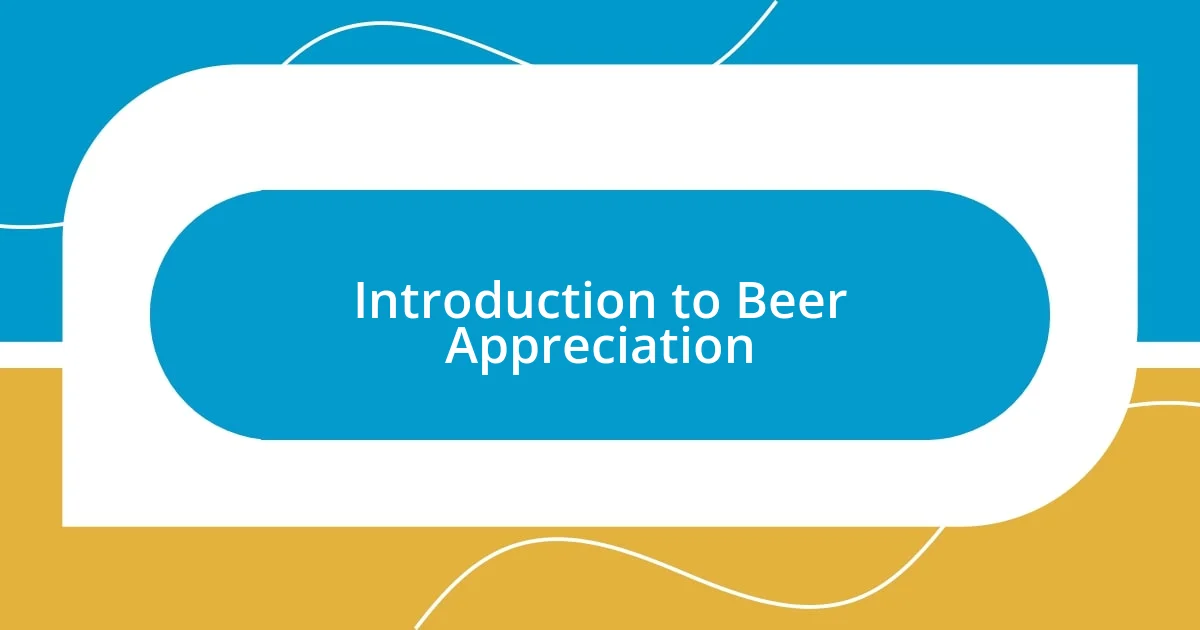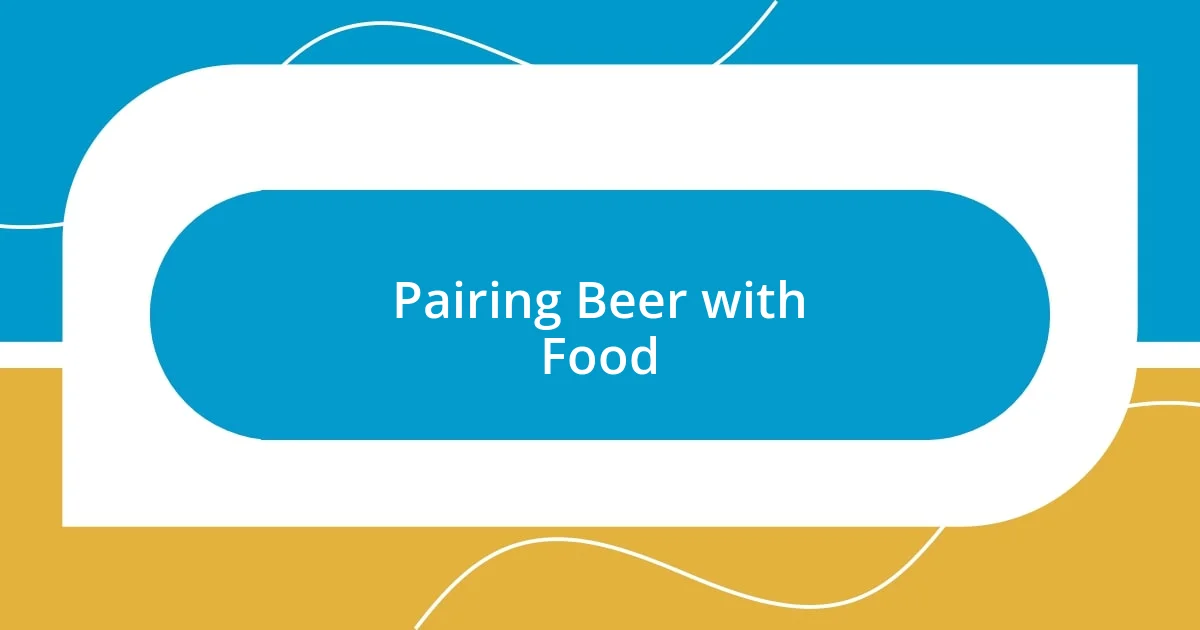Key takeaways:
- Beer appreciation is not just about drinking; it involves understanding the craftsmanship, ingredients, and cultural stories behind each brew.
- Different beer styles offer unique flavor experiences, and pairing them with food can significantly enhance the overall tasting journey.
- Hands-on brewing demonstrations and interactive sessions with brewers could further enrich future beer appreciation classes, enhancing participant engagement and learning.

Introduction to Beer Appreciation
When I first dipped my toes into beer appreciation, I was surprised by how much depth there was beneath the surface. It’s not just about getting a buzz; it’s about understanding the craftsmanship behind each brew. Have you ever noticed the subtle differences between an IPA and a stout?
In my experience, attending a beer appreciation class opened my eyes and palate to a world of flavors I had never considered before. Each sip becomes a story, revealing the unique ingredients and brewing techniques. I remember the first time I detected a hint of citrus in a lager—the moment felt magical and completely transformed how I viewed beer.
Beer appreciation is a journey, much like wine tasting but with its own unique flair. It invites you to explore not just the taste but also the history and culture behind each brew. I realized that sharing these experiences with fellow enthusiasts enriches the journey, turning every beer into an opportunity for connection and discovery.

Overview of Beer Styles
Embarking on my beer appreciation adventure revealed a fascinating array of beer styles, each with its own character and charm. Learning about the differences in taste, aroma, and mouthfeel made me appreciate the hard work that goes into each brew. For instance, the creamy richness of a stout contrasted sharply with the crisp, refreshing notes of a pilsner, showcasing just how diverse the world of beer can be.
Here’s a snapshot of some popular beer styles that caught my attention during the class:
- Lager: Clean and crisp, lagers often showcase mild flavors, making them incredibly refreshing.
- IPA (India Pale Ale): Known for its hoppy bitterness, an IPA can be an exhilarating flavor experience with citrus and floral notes.
- Stout: Dark and robust, stouts often feature coffee or chocolate flavors, bringing warmth and depth to any occasion.
- Wheat Beer: Light and often fruity, wheat beers are perfect for summer sipping with a hint of sweetness.
- Saison: A farmhouse ale that’s fruity and spicy; it’s surprisingly complex and varied from one brew to another.
The excitement I felt as I sampled each style felt like unearthing hidden treasures—each one telling its own unique story. I discovered that pairing the right beer with food can elevate the entire dining experience, creating a symphony of flavors that left me eagerly anticipating the next pour.

Tasting Techniques and Tips
Tasting beer is an art, and there are techniques that can enhance the experience. One important tip is to take a moment before tasting to observe the beer’s color, clarity, and carbonation. I remember the first time I held a glass of amber ale up to the light; the rich hues and fine bubbles had me captivated even before the first sip. This initial observation sets the stage for what’s to come, inviting you to engage with the beer more deeply.
Next, when it’s time to taste, I suggest taking small sips, allowing the beer to coat your palate. This method helps in identifying the layers of flavors present. During my class, I found that focusing on different aspects, like sweetness or bitterness, helped me articulate what I enjoyed about each beer more clearly. It was during this process that I discovered I had a fondness for the nuanced caramel notes in a malty amber.
Lastly, don’t forget to take notes as you taste! Whether it’s jotting down your impressions or marking favorites, I found that keeping a beer journal deepened my understanding of what I liked. Every note serves as a reminder of those delightful moments—like the time I recorded an exquisite smoky flavor in a porter that surprised me utterly. It made me appreciate the storytelling aspect of each brew.
| Tasting Technique | Description |
|---|---|
| Observation | Assess the beer’s appearance before tasting. Look for color, clarity, and carbonation. |
| Tasting | Take small sips to savor the layers of flavors, focusing on sweetness, bitterness, and more. |
| Note-taking | Document your impressions to track preferences and enhance your tasting experience. |

Pairing Beer with Food
Pairing beer with food can be a delightful journey, transforming a simple meal into an extraordinary experience. I vividly remember enjoying a tangy goat cheese salad with a crisp wheat beer. The effervescent notes of the beer cut through the richness of the cheese, creating a balance that left my taste buds dancing. This moment made me think about how much more enjoyable food can be when paired with the right brew.
It’s fascinating to explore how different beer styles complement various cuisines. For instance, I once paired a hoppy IPA with spicy Thai curry, and the contrast was simply magical. The hops in the beer toned down the heat while elevating the flavors in the dish. Have you ever pondered why certain combinations just work? It’s often about finding harmony between the dish’s intensity and the beer’s flavor profile, allowing one to enhance the other.
Don’t shy away from experimentation! During a casual dinner with friends, I introduced them to the surprisingly delightful combination of dark chocolate dessert with a rich stout. The flavors melded together beautifully, and we couldn’t stop raving about it. Those moments—creating memories around food and beer—are what truly make the experience unforgettable. It’s all about finding your favorites and enjoying the exploration along the way.

Understanding Beer Ingredients
Understanding the ingredients that go into beer is a revelation in itself. From my experience in the class, I learned that the four main components—water, malt, hops, and yeast—all play unique roles in crafting each brew. For instance, malt is the backbone of the beer, contributing sweetness and body. I remember being surprised to discover how different types of malt, from pale to roasted, can dramatically affect the flavor—like when I tasted a stout that balanced its bitterness with a silky caramel undertone from the dark malt.
Hops are another fascinating ingredient, often seen as the diva of beer. These little green cones impart bitterness and aroma, and they can evoke everything from floral to citrusy notes. During a tasting, I vividly recall the burst of grapefruit in a West Coast IPA; it felt as though a slice of summer had landed in my glass! Isn’t it intriguing how one ingredient can transform the perception of an entire beer?
Let’s not forget yeast, the unsung hero in the brewing process. This microorganism converts sugars from the malt into alcohol, but its impact doesn’t stop there. The yeast strain chosen can create distinct flavors—think banana and clove in some hefeweizens. I had an “aha” moment when I understood how these flavors developed during fermentation, making each beer’s personality shine. Have you ever considered how much a single ingredient contributes to the complexity and enjoyment of beer? Understanding these elements truly enhances the tasting journey, inviting us to savor each sip with newfound appreciation.

My Personal Insights and Takeaways
I found myself reflecting deeply on the sensory journey during the tasting exercises in the class. As I savored each sip, I realized how my palate has evolved. Remembering the first beer I ever enjoyed, a light lager, I chuckle at how much I’ve learned since then about flavor profiles and notes. It made me appreciate not just the taste, but the entire experience behind it—how every sip tells a story. Isn’t it incredible how our tastes can transform?
Another takeaway was the sheer joy of sharing this experience with others. During a group tasting, we all had different favorites—some loved the malty sweetness of brown ales, while others favored the bitterness of IPAs. Witnessing this diversity made me think about how personal our preferences are, and how beer can be such a facilitator of conversations and connections. It was a lovely reminder that each person’s journey with beer is unique, just like our own stories.
Most importantly, I learned that beer appreciation is about more than just drinking; it’s about the art, the science, and the community behind it. As I chatted with fellow enthusiasts, I felt a surge of excitement at the prospect of attending more tastings and trying new styles. What if I could discover a new favorite brew that resonates with my experiences or emotions? This class ignited my passion not just to enjoy beer but to dive deeper into the expansive world of brewing.

Recommendations for Future Classes
One recommendation for future classes is to incorporate more hands-on brewing demonstrations. I remember the excitement I felt when the instructor showed us how to hop a brew—actually seeing the process in action added another layer of understanding. It was fascinating to understand the timing and technique involved, and I believe this practical approach could deepen the appreciation for each craft.
Additionally, I think varying the food pairings could significantly enhance the experience. During one of the tastings, we had a selection of cheeses that perfectly complemented the beers we sampled. This sparked a delightful exploration of how flavor combinations can elevate both food and drink. Have you ever tasted a rich stout alongside a creamy blue cheese? It was an explosion of flavors that I never thought possible, and I’d love to see future classes experiment with different cuisines to inspire new flavor journeys.
Another idea is to include more opportunities for participant interaction, like structured discussion groups or a Q&A segment with local brewers. I found myself wanting to know more about the stories behind individual brews and the passion that drives their creation. Connecting directly with the individuals who craft these beers would not only personalize the experience but also convey the rich narratives intertwined with each bottle. Isn’t there something special about exchanging ideas and insights with the people behind your favorite brew? Engaging with the community in this way could truly enrich future classes.














